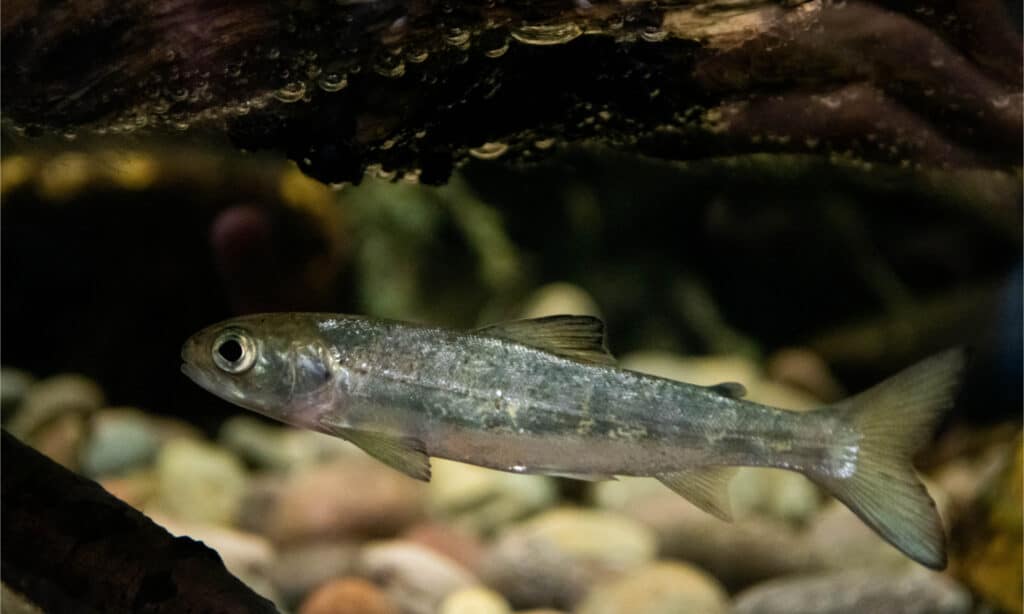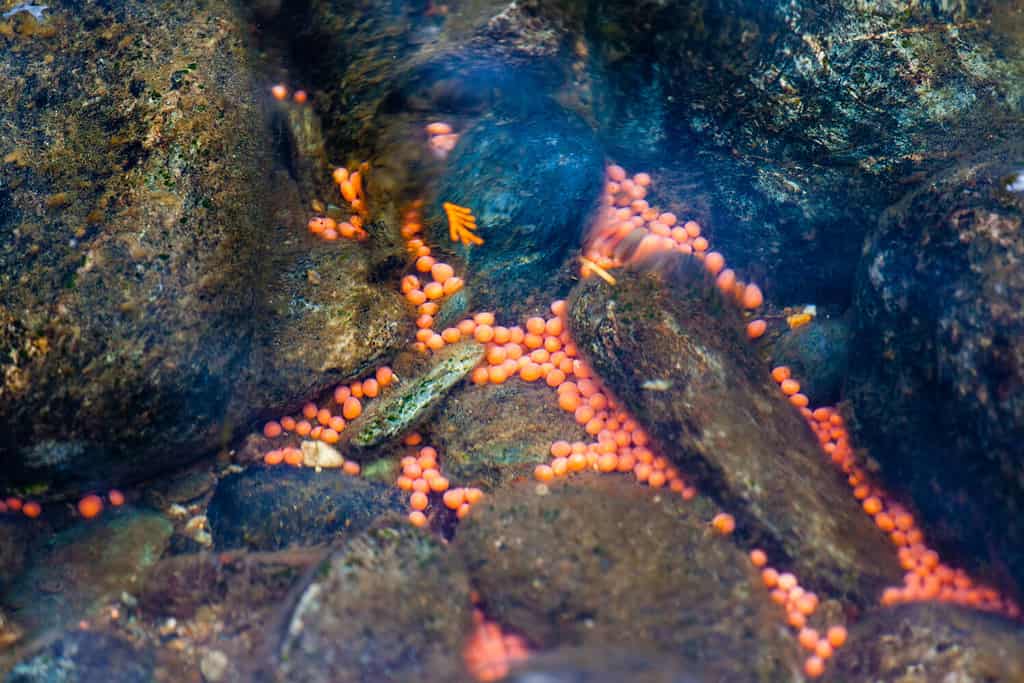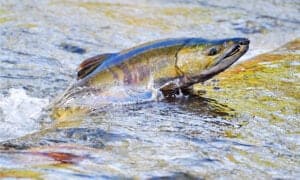The salmon migration, also called a salmon run, is an annual event where various salmon species return from the ocean to their freshwater spawning locations. Why do salmon migrate? The distances, places, and reasons for travel are explained below.
Why Do Salmon Migrate?

Salmon undergo massive migrations because there are more ocean resources than rivers.
©Sekar B/Shutterstock.com
Salmon migrate to sea once they hatch because the ocean has more resources than freshwater ecosystems. This means that the fish can grow much more significantly in a smaller window than possible if they stay where they were born. Getting bigger faster means there’s less of a chance of being eaten, and females will be able to lay more eggs.
Almost all salmon die after spawning, so their migration occurs at the end of their life. This happens because it doesn’t make sense biologically for a giant fish to spend the energy traveling back to the ocean. Also, they’ve expended so much energy swimming against currents to get where they need to go that their bodies are battered and used up. As a result, it makes sense for their life to end after they’ve fulfilled their reproductive mission.
Regional Destinations in the United States That Expect a Salmon Migration

Bears and other predators in the Pacific Northwest look forward to the salmon run.
©iStock.com/Mark Kostich
The Pacific Northwest in North America expects a significant salmon migration from roughly September through November every fall. In this geographical area, salmon are considered a keystone species and vital to hibernating animals’ survival. During the salmon runs, bears and other predators fatten up on the abundance of fish, crowding up freshwater streams.
The immense biomass in the Pacific Northwest produced by the salmon run is also vital to birds of prey and shorebirds. Also, the decaying bodies of the adults after spawning nourish the soil and banks of these waterways while washing nutrients through water channels—small creatures like invertebrates and plant life in the ecosystem access these nutrients and bits of fish.
Atlantic salmon migrate up river systems in Maine from the Atlantic Ocean. This is a small fraction of their historic range, which used to stretch down to New York’s Hudson River. However, efforts have been made in recent years to reintroduce Atlantic salmon to their historic breeding grounds.
Distances That Salmon Migrate Around the World
Salmon are a kind of fish that lives in the Northern Hemisphere. There are seven species in the Pacific Ocean, with 5 of those species migrating up North American river systems. The two other species utilize Asian rivers. In the Atlantic, there is one species of salmon.
Atlantic salmon leaving Maine’s rivers swim as far as Greenland to their feeding grounds. Populations of Atlantic salmon also spawn in European waterways, such as rivers in Norway. They’re found from Spain through Russia and feed near Greenland during their oceanic lives.
Pacific salmon spawn in California, Oregon, Washington, and Idaho. Once they’re old enough to return to the ocean, they spend a few years traveling over a thousand miles up and down the West Coast. They sometimes wander far into the open Pacific Ocean in search of food.
In East Asia, salmon runs occur as far north as Siberia through Korea and in Japan. These salmon spend their lives traversing the shores of Asia and traveling out into the middle of the Pacific Ocean in search of food.
What is the Reason Salmon Travel So Far?

Salmon smolts leave their rivers for the ocean for the opportunity to grow much more significant.
©jack perks/Shutterstock.com
Salmon travel so far from their spawning grounds following food resources. In freshwater habitats, it takes a salmon one to two years to grow up to three and a half inches long. Once they reach this size, they travel to the oceans.
In the ocean, they spend a couple of years or more growing up to two and a half feet in length on average for most species. However, king salmon reach over four and a half feet long in a span of one to 6 years.
This massive difference in growth rate is possible because the quantity and quality of prey in the ocean sustain much more rapid growth than what’s provided in riverine habitats. By investing their biology and lives into bulking up in the sea, they can lay better eggs in much larger quantities than would be possible if they stuck to the rivers from which they came.
Returning to areas deep within river systems and laying eggs in gravel beds of creeks in freshwater environments is a lot safer than spawning in the ocean. By growing in the sea and returning to their freshwater breeding grounds later in life, they end up laying the eggs in the best place possible.
Baby salmon also have a better chance of survival in riverine systems because there are more hiding places and fewer predators to eat them while they age. This is the impetus behind why salmon undertake such massive migrations from their birthplace to feeding grounds in the open ocean.
Why Do Salmon Return to the Same Spot They Hatched?
Salmon return to the same spot where they hatched because it’s a vetted area. They know it has the resources needed for the success of their offspring.
Since they survived there, they know that spawning in the exact location provides the habitat needed to live. They also know that there will be mates there to reproduce with. Salmon spend a few years slowly growing large enough to migrate back to the ocean. This means they need the perfect habitat.
How Salmon Know Their Way Back to the Same Place

Salmon find their way back to where they hatched by using the planet’s magnetic field and smell.
©Ronnie Chua/Shutterstock.com
Salmon migrate so far with such precision by orienting themselves via the planet’s magnetic field. Once they’re near the freshwater system they came from, they identify which rivers and streams to traverse based on their smell.
They note how the area smells as they exit their stream to begin their oceanic life. They use these memories to return years later when it’s their turn to spawn.
On their return journey, salmon sometimes get lost or can’t return to their historic grounds. When this happens, some salmon search for the right spot until they die. Others adapt and find places with suitable habitats occupied by other salmon and spawn there.
Thank you for reading! Have some feedback for us? Contact the AZ Animals editorial team.








